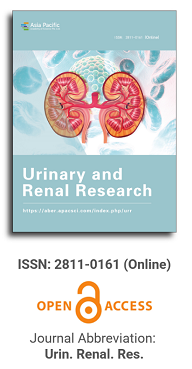
Asia Pacific Academy of Science Pte. Ltd. (APACSCI) specializes in international journal publishing. APACSCI adopts the open access publishing model and provides an important communication bridge for academic groups whose interest fields include engineering, technology, medicine, computer, mathematics, agriculture and forestry, and environment.
Urinary lithiasis in pediatrics
Vol 5, Issue 1, 2024
Download PDF
Abstract
Renal lithiasis is an infrequent entity in childhood and its incidence is increasing in developed countries. It affects white individuals more than African-Americans in a 4:1 ratio, with male predominance. There are geographical, racial and genetic factors involved in its pathogenesis, which also depends on physicochemical factors (renal elimination of water and solutes, urinary pH, balance between factors that stimulate/inhibit crystallization), anatomical alterations, infections and socioeconomic changes; which over time have produced changes in dietary habits, which have modified the frequency, chemical composition and location of calculi. Despite its rarity, lithiasis should be considered in order to avoid irreversible renal damage. The availability of less aggressive therapy has reduced surgical indications to 5%, opening new perspectives in the treatment of urolithiasis in childhood.
Keywords
References
- Lagomarsino E, Ávila D, Baquedano P, Cavagnaro F, Céspedes P. Urinary lithiasis in pediatrics. Revista chilena de pediatría. 2003;74(4):381-8. https://doi.org/10.4067/S0370-41062003000400005
- Kliegman R, Stanton B, St Geme J, Shor N. Nelson Treatise on Pediatrics. 20. Barcelona: ELsevier; 2016.
- Durán Álvarez S. Urolithiasis in children. Cuban Journal of Pediatrics. 2013;85(3):371-85.
- Montalvo C, Gómez A. Treatment of pediatric urolithiasis in our setting. Cir Pediatr. 2013;26(3):119-23.
- Camacho Díaz J, Casas Gómez J, Amat Barnés A, Giménez Llort A, García García L. Renal lithiasis in children. Anales españoles de pediatria. 1996;44(3):225-8.
- Rodrigo M, Vicente C. Idiopathic renal lithiasis and hypercalciuria. Protoc diagn ter pediatr. 2014;:150-70.
- Paris E, Sánchez I, Beltramino D, Copto A. Meneghello. Argentina: Panamericana; 2014.
- Habbig S, Beck B, Hoppe B. Nephrocalcinosis and urolithiasis in children. Kidney Int. 2011 Sept 28;80(12):1279-91. https://doi.org/10.1038/ki.2011.336
- Sáez-Torres C, Rodrigo D, Grases F, García-Raja AM, Gómez C, Lumbreras J, et al. Urinary excretion of calcium, magnesium, phosphate, citrate, oxalate and uric acid by healthy schoolchildren following a 12-h collection protocol. Pediatric nephrology. 2014;29:1201-8. https://doi.org/10.1007/s00467-014-2755-1
- Susaeta R, Benavente D, et al. Diagnosis and management of renal lithiasis in adults and children. Clinica Las Condes Medical Journal. 2018;29(2):197-212. https://doi.org/10.1016/j.rmclc.2018.03.002
- J.M. Alapont Alacreu, J.A. Queipo Zaragoza, J.P. Burgués Gasión, E. Broseta Rico, A. Serrano Durbá, F. Boronat Tormo, J.F. Jiménez Cruz. Treatment with extracorporeal shock wave lithotripsy in children: our experience. Subscribe to:Actas Urológicas Españolas. 2002;26(1):15-9. https://doi.org/10.1016/S0210-4806(02)72722-8
Supporting Agencies
Copyright (c) 2024 Author(s)

This work is licensed under a Creative Commons Attribution-NonCommercial 4.0 International License.

This site is licensed under a Creative Commons Attribution 4.0 International License (CC BY 4.0).
.png)
Prof. Wei-Yen Hsu
National Chung Cheng University, Taiwan

